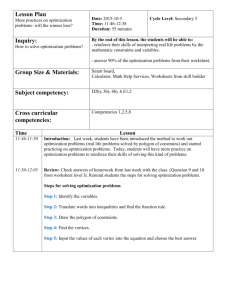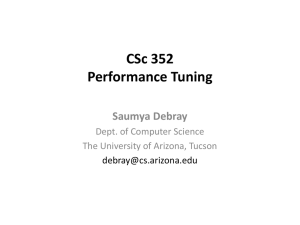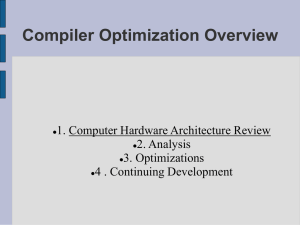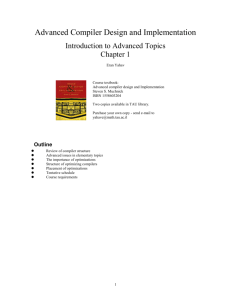Machine code optimization
advertisement
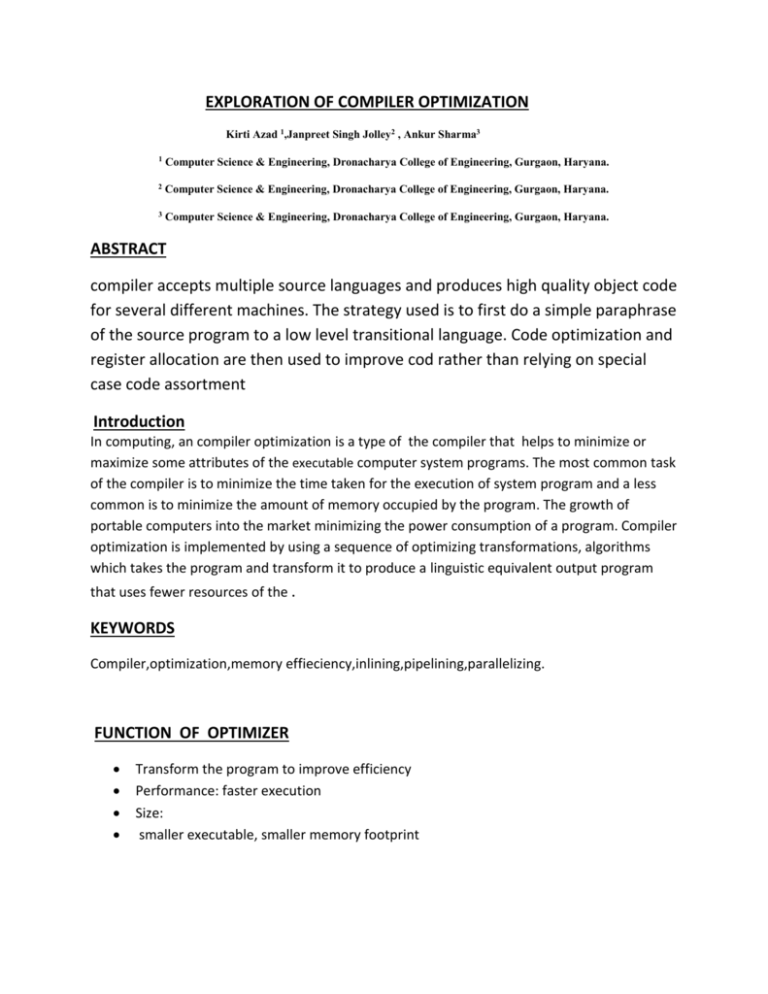
EXPLORATION OF COMPILER OPTIMIZATION Kirti Azad 1,Janpreet Singh Jolley2 , Ankur Sharma3 1 Computer Science & Engineering, Dronacharya College of Engineering, Gurgaon, Haryana. 2 Computer Science & Engineering, Dronacharya College of Engineering, Gurgaon, Haryana. 3 Computer Science & Engineering, Dronacharya College of Engineering, Gurgaon, Haryana. ABSTRACT compiler accepts multiple source languages and produces high quality object code for several different machines. The strategy used is to first do a simple paraphrase of the source program to a low level transitional language. Code optimization and register allocation are then used to improve cod rather than relying on special case code assortmentng on special case code selection. compilerccepts multiple source l Introduction In computing, an compiler optimization is a type of the compiler that helps to minimize or maximize some attributes of the executable computer system programs. The most common task of the compiler is to minimize the time taken for the execution of system program and a less common is to minimize the amount of memory occupied by the program. The growth of portable computers into the market minimizing the power consumption of a program. Compiler optimization is implemented by using a sequence of optimizing transformations, algorithms which takes the program and transform it to produce a linguistic equivalent output program that uses fewer resources of the . KEYWORDS Compiler,optimization,memory effieciency,inlining,pipelining,parallelizing. FUNCTION OF OPTIMIZER Transform the program to improve efficiency Performance: faster execution Size: smaller executable, smaller memory footprint FIG 1.1 OPTIMIZATION BOTH IN OPTIMIZER AND BACK END OPTIMIZATION IN THE BACK END > Register Allocation > Instruction Selection > Peep-hole Optimization 1.Register Allocation Processor has only finite amount of registers — Can be very small (x86) — Temporary variables — non-overlapping temporaries can share one register Passing arguments via registers Optimizing register allocation very important for good performance — Especially on x86 2. Instruction Selection For every expression, there are many ways to realize them for a processor Example: Multiplication*2 can be done by bit-shift Instruction selection is a form of optimization. 3. PEEPHOLE OPTIMIZATION Simple local optimization Look at code “through a hole” — replace sequences by known shorter ones — table pre-computed FIG 1.3 Major work is done in optimization phase EXAMPLES OF OPTIMIZATION > Constant Folding / Propagation > Copy Propagation >Strength Reduction > Dead Code Elimination — Structure Simplifications > Code Inlining Constant Folding / Propagation: > Evaluate constant expressions at compile time > Only possible when side-effect freeness guaranteed CONSTANT PROPAGATION > Variables that have constant value, e.g. c := 3 — Later uses of c can be replaced by the constant — If no change of c between! Analysis needed, as b can be assigned more than once! COPY PROPAGATION > for a statement x := y > replace later uses of x with y, if x and y have not been changed. STRENGHT PROPAGATION > Replace expensive operations with simpler ones > Example: Multiplications replaced by additions Peephole optimizations are often strength reductions DEAD CODE > Remove unnecessary code — e.g. variables assigned but never read > Remove code never reached CODE INLINING > All optimization up to know where local to one procedure > Problem: procedures or functions are very short — Especially in good OO code! — Solution: Copy code of small procedures into the caller — OO: Polymorphic calls. Which method is called? \ Techniques used in optimization can be broken up among various scopes which can affect anything from a single statement to the entire program. Generally speaking, locally scoped techniques are easier to implement than global ones but result in smaller gains. Some examples of scopes include: Peephole optimizations Usually performed late in the compilation process after machine code has been generated. This form of optimization examines a few adjacent instructions (like "looking through a peephole" at the code) to see whether they can be replaced by a single instruction or a shorter sequence of instructions. For instance, a multiplication of a value by 2 might be more efficiently executed by left-shifting the value or by adding the value to itself. (This example is also an instance of strength reduction.) Local optimizations These only consider information local to a basic block.[1] Since basic blocks have no control flow, these optimizations need very little analysis (saving time and reducing storage requirements), but this also means that no information is preserved across jumps. Global optimizations These are also called "intraprocedural methods" and act on whole functions.[2] This gives them more information to work with but often makes expensive computations necessary. Worst case assumptions have to be made when function calls occur or global variables are accessed (because little information about them is available). Loop optimizations These act on the statements which make up a loop, such as a for loop . Loop optimizations can have a significant impact because many programs spend a large percentage of their time inside loops. Interprocedural, whole-program or link-time optimization These analyze all of a program's source code. The greater quantity of information extracted means that optimizations can be more effective compared to when they only have access to local information (i.e., within a single function). This kind of optimization can also allow new techniques to be performed. For instance function inlining, where a call to a function is replaced by a copy of the function body. Machine code optimization These analyze the executable task image of the program after all of an executable machine code has been linked. Some of the techniques that can be applied in a more limited scope, such as macro compression (which saves space by collapsing common sequences of instructions), are more effective when the entire executable task image is available for analysis.[3] In addition to scoped optimizations there are two further general categories of optimization: Programming language–independent vs language-dependent Most high-level languages share common programming constructs and abstractions: decision (if, switch, case), looping (for, while, repeat.. until, do.. while), and encapsulation (structures, objects). Thus similar optimization techniques can be used across languages. However, certain language features make some kinds of optimizations difficult. For instance, the existence of pointers in C and C++ makes it difficult to optimize array accesses (see alias analysis). However, languages such as PL/1 (that also supports pointers) nevertheless have available sophisticated optimizing compilers to achieve better performance in various other ways. Conversely, some language features make certain optimizations easier. For example, in some languages functions are not permitted to have side effects. Therefore, if a program makes several calls to the same function with the same arguments, the compiler can immediately infer that the function's result need be computed only once. In languages where functions are allowed to have side effects, another strategy is possible. The optimizer can determine which function has no side effects, and restrict such optimizations to side effect free functions. This optimization is only possible when the optimizer has access to the called function. Machine independent vs machine dependent Many optimizations that operate on abstract programming concepts (loops, objects, structures) are independent of the machine targeted by the compiler, but many of the most effective optimizations are those that best exploit special features of the target platform. E.g.: Instructions which do several things at once, such as decrement register and branch if not zero. The following is an instance of a local machine dependent optimization. To set a register to 0, the obvious way is to use the constant '0' in an instruction that sets a register value to a constant. A less obvious way is to XOR a register with itself. It is up to the compiler to know which instruction variant to use. On many RISC machines, both instructions would be equally appropriate, since they would both be the same length and take the same time. On many other microprocessors such as the Intel x86 family, it turns out that the XOR variant is shorter and probably faster, as there will be no need to decode an immediate operand, nor use the internal "immediate operand register". (A potential problem with this is that XOR may introduce a data dependency on the previous value of the register, causing a pipeline stall. However, processors often have XOR of a register with itself as a special case that doesn't cause stalls.) Factors affecting optimization The machine itself Many of the choices about which optimizations can and should be done depend on the characteristics of the target machine. It is sometimes possible to parameterize some of these machine dependent factors, so that a single piece of compiler code can be used to optimize different machines just by altering the machine description parameters. GCC is a compiler which exemplifies this approach. The architecture of the target CPU Number of CPU registers: To a certain extent, the more registers, the easier it is to optimize for performance. Local variables can be allocated in the registers and not on the stack. Temporary/intermediate results can be left in registers without writing to and reading back from memory. RISC vs CISC: CISC instruction sets often have variable instruction lengths, often have a larger number of possible instructions that can be used, and each instruction could take differing amounts of time Pipelines: A pipeline is essentially a CPU broken up into an assembly line. It allows use of parts of the CPU for different instructions by breaking up the execution of instructions into various stages: instruction decode, address decode, memory fetch, register fetch, compute, register store, etc. One instruction could be in the register store stage, while another could be in the register fetch stage Number of functional units: Some CPUs have several ALUs and FPUs. This allows them to execute multiple instructions simultaneously. The architecture of the machine Cache size (256 kiB–12 MiB) and type (direct mapped, 2-/4-/8-/16-way associative, fully associative): Techniques such as inline expansion and loop unrolling may increase the size of the generated code and reduce code locality. The program may slow down drastically if a highly utilized section of code (like inner loops in various algorithms) suddenly cannot fit in the cache. Also, caches which are not fully associative have higher chances of cache collisions even in an unfilled cache. Cache/Memory transfer rates: These give the compiler an indication of the penalty for cache misses. This is used mainly in specialized applications. General purpose use Prepackaged software is very often expected to be executed on a variety of machines and CPUs that may share the same instruction set, but have different timing, cache or memory characteristics. So, the code may not be tuned to any particular CPU, or may be tuned to work best on the most popular CPU and yet still work acceptably well on other CPUs. Special-purpose use If the software is compiled to be used on one or a few very similar machines, with known characteristics, then the compiler can heavily tune the generated code to those specific machines (if such options are available). Important special cases include code designed for parallel and vector processors, for which special parallelizing compilers are employed. Conclusion: As we can see from our above discussion , code optimization or compiler optimization is one of te phase of compiler design that enchance the performance of the processes, running on the system by reducing the memory usage and by tries to min. or max. some attribute of executable program. Also we saw some factors which affect the optimization process and lots of techniques used in compiler optimization. References 1. Brian Kernighan and Rob Pike. The Practice of Programming. AddisonWesley Professional, 1999. 2. Bill Pugh. Is Code Optimization Research Relevant? Re-trieved October 20, 2009 from http://www.cs.umd.edu/~pugh/ IsCodeOptimizationRelevant.pdf, 2002. 3. Herbert Xu. Builtin memcmp() could be optimised. Retrieved October 20, 2009 from http://bugs.debian.org/cgi-bin/bugreport.cgi?bug= 85535, February 2001. 4. Todd Proebsting. Proebsting's Law. Retrieved October 20, 2009 from http://research.microsoft.com/en-us/um/people/toddpro/ papers/law.htm, 1998. LIST OF WEB PAGES 1.www. Wikkipedia.com 2.www.ghacks.com 3.www.yahooanswers.com 4.www.ehow.com

